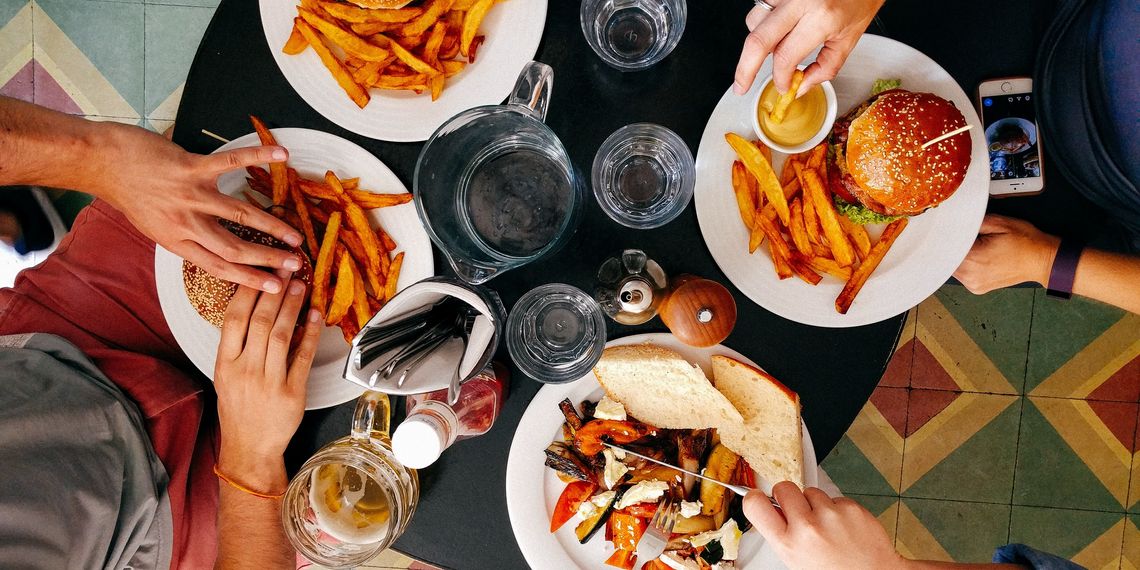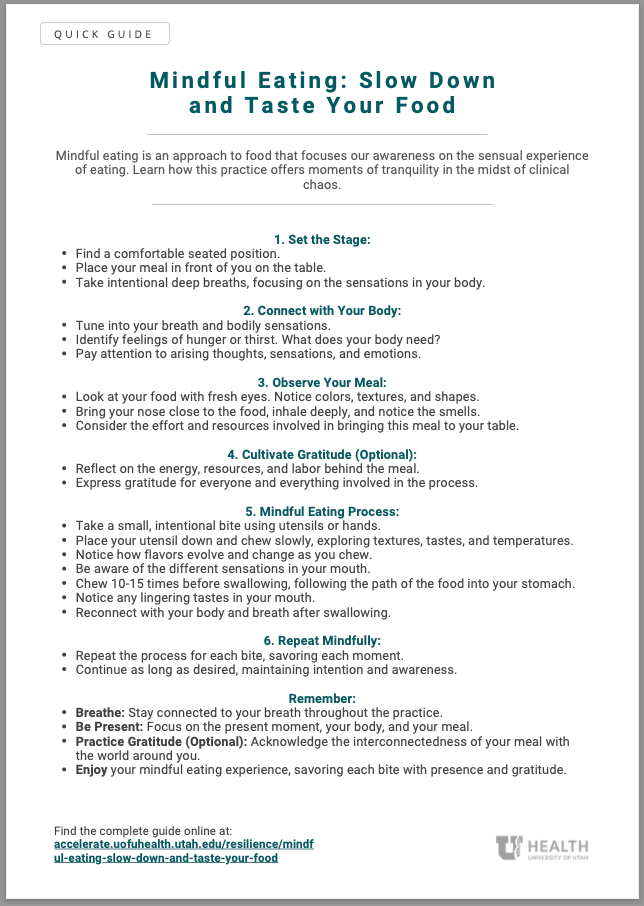pediatric house staff, my co-residents and I developed a keen ability to provide skillful and compassionate care under stressful conditions. This included managing high patient volumes, treating complex and critical medical problems, juggling intense expectations from attendings and families, and acquiring the competence and confidence of future seasoned physicians. In short, we accomplished what all health professional trainees—be it physicians, dentists, nurses, APPs, therapists—accomplish. We ran the gauntlet and came out the other end with the ability to care adroitly for patients.
In training and beyond, health professionals must be able to complete a massive list of tasks in a limited amount of time, which requires focus, diligence, grit, and efficiency. I am willing to bet the bank that I am not the only health care provider to have developed some unsavory eating habits to maximize efficiency in this challenging environment. I will spare you the daily menu, mainly overly sweet or salty carb-laden, fat-heavy beige food. Instead, for purposes of this article, I will focus on the insane speed with which calories were consumed, to the point that ingesting food was akin to filling the gas tank of a Formula 1 racecar during a pitstop, as opposed to a cherished experience amongst friends and family. More common than not, eating commenced while waiting in the cafeteria check-out line, continued full stride enroute to the elevator, and finished (dessert included) upon arrival to the nursing station. This is no exaggeration.
How then, you might ask, does mindful eating come into play? What is mindful eating? How does it work? What are the benefits? And is it even possible in our clinical environments?
Mindfulness in Medicine Toolkit

Click here for a list of resources you and your team can use to practice mindfulness and increase your well-being.
What is Mindful Eating?
Mindful eating is an approach to food that focuses our awareness on the sensual experience of eating. It is the opposite of mindlessly, and usually rapidly, shoveling food down on autopilot while paying attention to something other than eating. When we eat mindfully, we pay attention to our food (the smells, temperature, colors, textures, flavors) on purpose, moment by moment. We intentionally slow down the eating process, and, fully present, savor the experience. We tap into the pleasure of food and bring a sense of joy and gratitude towards our abundance and the efforts and resources required to bring food to our tables. In a busy clinical environment, eating mindfully, even for a brief period of time, can serve as a respite from the daily chaos and provide a wonderful opportunity to experience the immense pleasure that food and drink brings to us.
Practicing Mindful Eating
If you are new to mindful eating, a good time and place to introduce yourself to the practice is when you are not under significant time pressure, not self-conscious about eating slowly, and able to put your phone down and step away from the computer. With practice, you will become quite adept at mindful eating, even when things are busy at work.
Short moments of focused awareness on our meal can have dramatic benefits to our sense of wellbeing and pleasure in food.
Mindful Eating – A Guided Exercise
Begin in a comfortably seated position, with your meal sitting on the table in front of you. Take a few intentional in and out breaths, connecting to the flow of air as it enters and then leaves the body, either at the nose, the back of the throat, or in the expansion and relaxations of the chest or abdomen.
After tuning into your breath, attend to your feet on the floor, your sit-bones in the chair, and the sensation of gravity on the body. Continue breathing into this moment, bringing awareness to any arising thoughts, sensations, or emotions.
(Pause)
Next, bring awareness to the sensations in your body as you prepare to eat. Is there a feeling of hunger or thirst? What are you hungry or thirsty for? Where is that most felt? What does your body need right now? Simply pay attention to what your body is telling you, as you sit in front of your meal.
(Pause)
Mindful habits

Click here to learn about three ways we can build habits that support individual resilience.
Now, bring your attention to the food in front of you. Imagine you are seeing it for the first time. Observe with curiosity, the colors, shading, textures, shapes. What jumps out at you? What is more subtle?
(Pause)
Next, bring your nose close to this newly discovered offering. Breathe in deeply through your nose, capturing the smells. What do you notice? Is there anything familiar about the smell? Anything new? Can you sense temperature? Linger for a moment on your olfactory sense.
(Pause)
As you continue paying attention to the sights and smells before you, consider the immense amount of energy in resources and labor it took to bring this meal to your table: the sunshine and water to grow the food; the many hands and machinery required to cultivate, pick, process and package the food; the time, fuel, and care to safely ship, unload, and store the food. You may choose to bring gratitude for everyone and everything involved in the meal in which you are about to partake. Feel free, if it is part of your practice or spiritual tradition, to bring your own gratitude or blessing to this moment.
(Pause)
Now, with a utensil or with your hands, whichever is appropriate for the food you are about to enjoy, take a small, intentional bite. After placing your utensil down, begin chewing slowly, bringing awareness to the textures, taste, and temperature. Notice how these factors change, and how the flavors evolve as you slowly chew. Feel the different parts of the mouth involved in chewing. Sense the smoothness, hardness, crunchiness, or stickiness, as you chew. Notice the sounds and movements of the mouth and face. If you can, chew 10-15 times before swallowing. When you swallow, notice the path that the food follows from your mouth and throat into your stomach, paying attention to tastes that may linger in your mouth. Connect again to your body and your breath and notice your experience in this moment.
(Pause)
Repeat this process of taking a bite, placing your utensil down, chewing 10-15 times, and swallowing, all with great intention and awareness, before moving on to the next bite. Feel free to continue this for as long as you would like.
Mindful movement

Click here to learn about practices that boost mental, physical, and emotional health, enhancing productivity and reducing stress for a more balanced life.
Reflections on Mindful Eating
Now take a few moments to reflect on this mindful eating exercise:
- How was this experience the same or different from how you normally eat?
- What, if anything, surprised you about the experience?
- What did you notice about the food in terms of sight, touch, sound, smell, and taste?
- What thoughts or memories popped up while doing this exercise?
- What is one tip for yourself that you are going to take from this experience to apply to your eating habits in the future?
The following questions and process can be applied to your eating on the job once you have established a foundation in the mindful eating using the guide detailed above.
- Before eating, take a large breath in and out to bring attention to the present moment.
- What can you notice about your body in this moment? Are you hungry or salivating?
- What can you notice about your food (sight, smell, and taste)?
- Take a bite and be aware of the process of eating.
- Did you maintain focus on the food the entire time eating? If not, what did your mind drift off to?
This program is supported by the Health Resources and Services Administration (HRSA) of the U.S. Department of Health and Human Services (HHS). The contents are those of the author(s) and do not necessarily represent the official views of, nor an endorsement, by HRSA, HHS, or the U.S. Government. For more information, please visit HRSA.gov.
David Sandweiss
Well-being expert and physician David Sandweiss explores the tangible sensations of earth, water, fire, and wind within you. Each element guides your awareness to the solidity of your bones, the fluidity of your breath, the warmth of your being, and the gentle breeze of your breath. By immersing yourself in these elemental experiences, you'll cultivate a profound sense of presence and gratitude for the miraculous intricacies of your own existence.
In the medical field, science and skill are paramount, but what about the crucial art of dealing with grief and loss? Physician David Sandweiss shares his transformative mindfulness journey through the profound impact of presence and compassion, and how it has reshaped his approach to patients.
Family Medicine physician and co-director of the Resiliency Center Amy Locke outlines five ways U of U Health’s strategic commitment to well-being is paying off during COVID-19.

